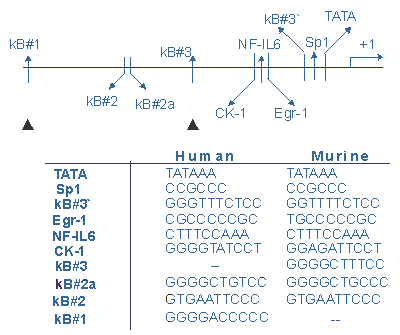Gene: [11q22/CASP1] caspase 1, apoptosis-related cysteine protease; interleukin 1, beta, convertase;
COM | Alternatively spliced gene, with key role in apoptosis, C elegans ced-3 homolog. |
FAG | Members of the ICE/CED-3 protease family play key biologic roles in inflammation and mammalian apoptosis." |
NOM | Alnemri-1996 proposed a nomenclature for the human members of this protease family. They recommended use of the trivial name 'caspase' as a root for serial names for all family members. The selection of caspase was based on 2 catalytic properties of these enzymes. The 'c' was intended to reflect a cysteine protease mechanism, and 'aspase' referred to their ability to cleave after aspartic acid, the most distinctive catalytic feature of this protease family. To designate individual family members, caspase was to be followed by an arabic number, assigned on the date of publication. Assignments for the 10 previously described proteases were given. The root symbol for the corresponding gene was to be CASP, and this gene was symbolized CASP1." |
MOD | Li-1997 generated ICE-deficient mice through gene targeting technology. ICE-deficient mice developed normally, appeared healthy, and were fertile. Peritoneal macrophages from ICE-deficient mice underwent apoptosis normally upon ATP treatment. Thymocytes from young ICE-deficient mice also underwent apoptosis when triggered by dexamethasone, gamma irradiation, or aging. The most striking result from the study was that the ICE-deficient mice were highly resistant to the lethal effects of endotoxin. With high-dose lipopolysaccharide that killed all wildtype mice within 30 hours, all ICE-deficient mice survived the first 48 hours and 70% of them survived after 7 days. These studies suggested the therapeutic potential of ICE inhibitors in inflammatory diseases such as septic shock and inflammatory bowel diseases." |
REL | GEM:07q35/CASP2; GEM:04q34/CASP3; GEM:11q22/CASP4; GEM:11q22/CASP5; GEM:04q2/CASP6; GEM:10q25/CASP7; GEM:00.0/CASP8; GEM:00.0/CASP9; GEM:02q3/CASP10. See also GEM:02q13/IL1A and FAM:IL/00.0." |
REF | NOM
"Alnemri ES &: Cell, 87, 171-171, 1996 COD,LOC,REL "Alnemri ES &: JBC, 270, 4312-4317, 1995 FUN "Casano FJ &: Genomics, 20, 474-481, 1994 GEN,SEQ "Cerretti DP &: Genomics, 20, 468-473, 1994 COD,SEQ "Cerretti DP &: Science, 256, 97-100, 1992 MOD,MOU "Li P &: J Cell Biochem, 64, 27-32, 1997 LOC "Nasir J &: Mammal Genome, 8, N8, 611-613, 1997 COD,LOC,REL "Smith MW &: Genomics, 17, 699-725, 1993 COD,LOC,REL "Tunnacliffe A &: Genomics, 17, 744-747, 1993 COD,LOC,REL "Vanagaite L &: Genomics, 22, 231-233, 1994 |
SWI | SWISSPROT: P29466 |
KEY | imm, pep |
CLA | coding, basic |
LOC | 11 q22.2-.3 |
MIM | MIM: 147678 |
EZN | ENZYME: 3.4.22.36 |
